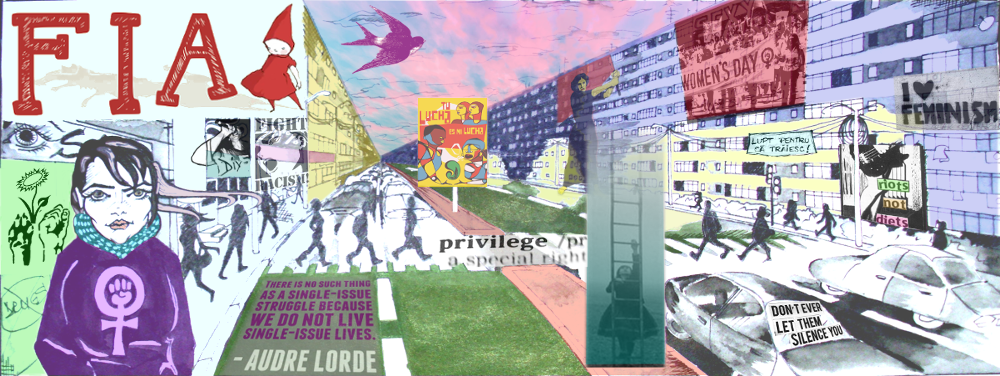from Rethinking Rape – A Site for Resistance and Activism:
(Laws and Definitions)
History of Rape Laws in the US:
In the mid-seventeenth century, Sir Matthew Hale introduced the idea of “a woman scorned” into English common law. The myth of the woman who is rejected by a man and then seeks revenge by falsely accusing him of rape remains prevalent in society even today. The creation of the myth of this vindictive woman serves to exonerate perpetrators of rape and in essence, perpetuate the notion that real rape is a rare offense that occurs between strangers. Until the 1970’s in America, jurors in rape cases were read Hale’s warning that although rape is a horrific crime “it is an accusation easy to be made, hard to be proved, but harder to be defended by the party accused, though innocent” (Reeves Sanday, 1996). Until only recently in our nation’s history, women in the United States were subject to male violence and had little to no recourse or any means of achieving justice.
The women’s movement of the 1960’s spawned the anti-rape movement which incited change in the legal arena and was the first time that acquaintance rape was identified and studied. Rape crisis centers, Take Back the Night marches, Speak Outs, feminist organizations, and published research accounts challenged the public’s ideologies regarding the definitions as well as the prevalence of the act of rape.
Rape law reform was an important aspect of the anti-rape movement. At this time, many traditional ideas and commonly held notions about rape were challenged; such as, the idea that the degree of a woman’s resistance was the deciding factor as to whether a rape occurred. Since the 70’s, resistance has become a less important determining factor in the law and the issue of verbal consent has become increasingly significant. The link between rape and alcohol, as well as other sedating substances, has only recently come into the anti-rape discourse and laws. Even today, the idea that a man could rape his wife is considered impossible to many in our society; in fact, marital rape remains noticeably absent from many state’s rape laws.
For a more thorough account of the evolution of rape laws in America check out Peggy Reeves Sanday’s amazing book: A Woman Scorned: Acquaintance Rape on Trial (1996)
OTHER HISTORIES:
- About the anti-rape movement in Chicago (& at Illinois State level)
- More on the History of the Rape Crisis Movement in the US
- The Rapist Who Pays the Rent– the handbook of the movement to make rape in marriage a crime [in Britain]
- About the anti-violence movement in Bulgaria and in (post-“communism”/post-“state feminism”) Eastern-Europe
- Stop Violence Against Women: Factsheet on Romania; database of anti-violence efforts and legislation in Romania [ro]
More from the history of the movement, its impact on laws, policies and public views and attitudes, its successes and failures:
- Confronting Rape: The Feminist Anti-Rape Movement and the State
- The Color of Violence Against Women
… Services Over Politics
Since the opening of the first rape crisis center in 1972 and the first domestic violence shelter in 1974, the mainstream anti-violence movement has been key to breaking the silence surrounding violence against women and providing critically needed services to survivors of sexual/domestic violence. The early anti-violence movement first prioritized a response to male violence based on grassroots political mobilization. However, as the anti-violence movement has gained greater public prominence, domestic violence and rape crisis centers have become increasingly professionalized to receive accreditation and funding from state and federal agencies. Rather than develop peer-based services in which large groups of women can participate, they employ individuals with the proper academic degrees or credentials. This practice excludes most women from full participation, particularly women of color and poor women. Professional service has eclipsed political organizing as the main work of domestic violence and sexual assault organizations.Over the years, the anti-violence movement has also become increasingly reluctant to address sexual and domestic violence within the larger context of institutional inequality and violence. For example, many state coalitions on domestic/sexual violence have refused to take stands against the anti-immigration backlash, arguing that this is not a sexual/domestic violence issue. However, as the anti-immigration backlash intensifies, many immigrant women do not report abuse–from the INS, police, employers or family members–for fear of deportation.
This narrow approach toward working against violence is problematic because sexual/domestic violence within communities of color cannot be addressed seriously without dealing with the larger structures of violence, such as militarism, attacks on immigrants and Indian treaty rights, police brutality, the proliferation of prisons, economic neo-colonialism, and institutional racism. It is simply futile to attempt to combat interpersonal violence without addressing the fact that we live in a world structured by violence. …
- Critical Resistance – Incite Statement: Gender Violence and the Prison Industrial Complex
- Putting Community Back in the Domestic Violence Movement
- Whose Safety?: Women of Color and the Violence of Law Enforcement (PDF)
- Without Bureaucracy, Beyond Inclusion: Recentering Feminism (PDF)

Pingback: ladyfest romania » Blog Archive » must read post & discussion
Pingback: FIA » Blog Archives » rasism - si solutii care agraveaza problema